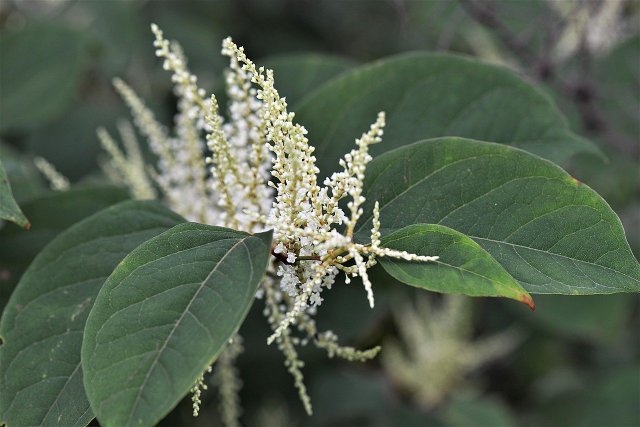
Japanese knotweed is a plant that is no longer welcome in Europe. Here you can read why this perennial is being fought at full speed and how you can get rid of it from your garden.
In keeping with its name, Japanese knotweed originated in Japan, China and Korea. It only came to Europe during the 19th century and was introduced here as a forage and ornamental plant. Japanese knotweed has hollow, sturdy stems that can grow up to three feet tall. The flowers are white and bloom from August to October.
Japanese knotweed: no longer desirable
Meanwhile, Japanese knotweed is no longer welcome in this country and is considered a so-called invasive neophyte. According to the EU, invasive species are “animal and plant species whose spread may affect habitats, species or ecosystems and therefore harm biodiversity.”
Japanese knotweed spreads extremely quickly, taking over large areas and thus displacing other plants. In this way, it not only endangers native nature, but also causes economic damage. With its strong stems, it damages walls, asphalt surfaces, pipes and river banks. For these reasons, it is now fought with great effort. The problem is that its roots, the rhizomes, break easily and any piece, no matter how small, can sprout anew.
Contents
Fight Japanese knotweed naturally

If you discover Japanese knotweed in your garden, you should act as soon as possible. The plants grow enormously fast and spread in no time. Since they cope with very difficult soil in their native habitat, they are also very adaptable here.
You must remove Japanese knotweed mechanically. Suitable herbicides are firstly not allowed and secondly not recommended anyway. Often they also damage the flora and fauna near the actual area of application.
You have several options to remove Japanese knotweed. Some of them are very tedious and not very effective.
- The best way is to consistently dig up the plant and pull it out. Dig deep enough so that no root fragments remain in the soil. You must be very thorough, otherwise you can be sure that the plant will sprout again. Repeat this procedure a few times.
- Alternatively, or if the plant has already infested a larger area, you can mow it down with a lawn mower every two weeks. This will not remove the rhizomes in the soil, but will greatly reduce the growth of the plant. Keep in mind that you must clean the mower thoroughly afterwards. No root fragments should be left on it, otherwise they can fall down in another place and sprout anew.
- Another option is to control them with a black sheet or tarp. If you cover the plants with it, sunlight will no longer reach them and they will gradually die. However, the whole process can take several years. Also, we don’t recommend using plastic when there are other more sustainable options.
Disposing of Japanese knotweed
In addition to thoroughly removing the knotweed, it’s equally important that you dispose of the plant parts properly. Do not simply throw it on the compost, as there is a possibility that it will sprout. Small amounts can be disposed of with household waste, but larger amounts should be taken to your local composting facility.
Use Japanese knotweed

The fact is that you should never deliberately grow Japanese knotweed. However, if you do come across a plant, whether in your garden or in the wild, you can use various parts of the plant in many ways.
The young shoots can be used as a kitchen ingredient. It is best to harvest those that are about 20 centimeters tall. These are still tender and can even be eaten raw.
- For example, cut them into fine rings and add them to salads or eat them with dips of your choice.
- Alternatively, you can make them into a fruit spread or compote. Proceed as with rhubarb. You can find instructions here: Rhubarb compote: How to cook the fruity dessert.
- They are also suitable as a garnish for soups or vegetable puree.
- If the leaves are large enough, you can use them as a substitute for aluminum foil. Wrap them around grilled potatoes or other grilled vegetables, for example.
Japanese knotweed is also said to be effective from the point of view of herbal medicine. It is said to have laxative, antiviral, anti-inflammatory, antipyretic and diuretic properties, among others. For example, tinctures or powders can be made from the plant parts. For skin diseases and inflammations, poultices made from crushed leaves and roots are said to help.


